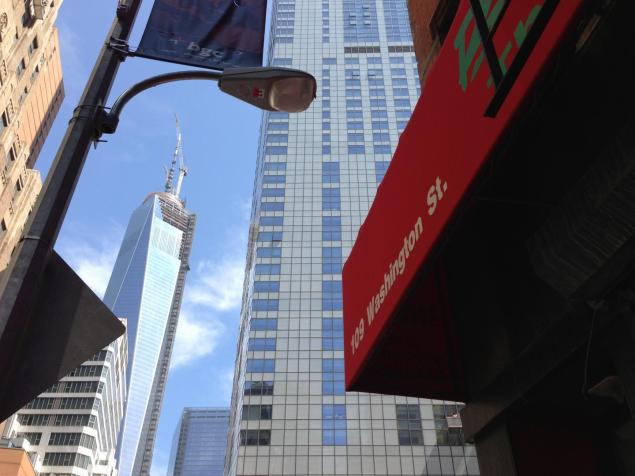By Carol Kuruvilla New York Daily News
The Chinese have Chinatown. The Italians have Little Italy. And before the Brooklyn-Battery Tunnel pummeled its way into Manhattan, people from the Middle East also shared a slice of the city’s history.

Today, Washington Street is right next to the new World Trade Center building. Carol Kuruvilla
The area around the World Trade Center was once the center of Arab-American life in New York City. But all that remains of sprawling “Little Syria” are three buildings: a community center, a tenement building and a church. Activists from Save Washington Street are trying to have these fading memories recognized at the National September 11 Memorial Museum.
“I think there’s a sense that anything Arab is dangerous,” said Todd Fine, co-founder of Save Washington Street. “It’s important for children of Arab Americans who are facing discrimination to know that this location is the start of their heritage.”
Immigrants from Syria and Lebanon started arriving in the 1880s and found homes in crowded tenements from Liberty Street to Battery Park.
Arab music drifted from the windows of coffee shops while peddlers hawked imported goods on the street. The community had a thriving literary scene and was home to one of the first Arabic printing presses.
Most of the immigrants who moved to New York were Christians, but a small number of Muslims were also mixed into the neighborhood. Men in fezzes brushed elbows with the German, Italian and Irish immigrants who lived nearby.
Carl Houck, a 22-year-old student at Brooklyn’s St. Francis College, has family members who started moving to Little Syria from Lebanon in 1892. They opened up an exporting business on 60-62 Washington St., sending dry goods such as jewelry to South America.
Houck’s grandmother grew up on the street and tells stories about the tight-knit community.
“People think that Middle Easterners are new here, that they have no place here,” Houck said. “But they’ve been coming here just as long and deserve the same respect and recognition that other immigrant groups have.”
Houck’s family eventually moved to Brooklyn, like many other Lebanese-Americans who were displaced from Little Syria by the Brooklyn-Battery Tunnel (now officially the Hugh L. Carey Tunnel).

All that remains of Little Syria are three buildings on Washington Street-a tenement building (far left), a community center (middle) and a church. Carol Kuruvilla
The dark windows of the community center stare empty onto a street that rings with the dusty clangs of construction.
Houck fears that the company that owns the building, Pink Stone Realty, may tear it down to build a high rise.
For many years, the former St. George’s Syrian Catholic Church was home to an Irish pub. The bar has moved and construction workers now tramp in and out of the building.
People still live in the old tenement building. But on the ground floor, the Syrian immigrants’ cigar factory has been replaced by a Thai and Chinese restaurant.
Houck became involved in Save Washington Street, a preservation group, after realizing that Little Syria was slipping away.
“Arab Americans today aren’t even aware of this place because it hasn’t been well-documented,” Houck said.
The activists have tried since 2009 to have the three remnants of Little Syria linked together as a historic district.
New York’s Landmarks Preservation Commission has recognized the former church, but the commission has declined to grant landmark status to the other two buildings, saying that they lack architectural significance.
So the activists are changing up their tactics — asking for Little Syria to be recognized by signage at the planned pedestrian plaza near Washington St. and in the permanent exhibit at the National September 11 Memorial Museum.
“It would help the thousands of tourists who visit the site to understand that Arab-Americans have played a patriotic role in the country’s history,” said Todd Fine. “It humanizes a group that sometimes can be dehumanized when discussing 9/11.”
The proposal to place signage around the Memorial received a positive response from Community Board 1’s financial committee.
Michael Levine, Community Board 1’s director of planning and land use, told the Daily News that he expects the full board to adopt the resolution. The Department of Transportation has final say over where exactly the sign will be placed.
But Save Washington Street hasn’t been as successful with the 9/11 Memorial museum. Its curators are not planning to include information about the area’s Arab American history in the museum’s permanent collection, a spokesperson said. However, they are open to recording oral histories or using information about Little Syria in educational materials or in future rotating or temporary exhibitions.
“We are including a wealth of stories in the Museum – varied and diverse – to document, preserve 9/11 history and to help educate a global public,” spokesperson Anthony Guido told the Daily News in a statement.
But the founding members of Save Washington Street don’t think this is enough.
“That’s pushing it off,” said Fine about relegating Little Syria to temporary exhibitions. “We know there’s so much confusion about Arab American history, why would you not use this opportunity to tell that story?”
Fine says his group doesn’t want to overshadow the memorial or disturb those who come to pay their respects to the thousands who lost their lives on September 11, 2001. But he worries that Arab American children who visit the museum will come away with an unbalanced perspective on their culture.
“It’s just good to recognize that there was life before death,” Fine said.
The Arab American National Museum is showcasing photos and artifacts from Little Syria in an exhibition titled “Little Syria, NY: An Immigrant Community’s Life & Legacy.” The exhibit is open in New York until May 27.

